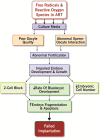The effects of oxidative stress on female reproduction: a review
- PMID: 22748101
- PMCID: PMC3527168
- DOI: 10.1186/1477-7827-10-49
The effects of oxidative stress on female reproduction: a review
Abstract
Oxidative stress (OS), a state characterized by an imbalance between pro-oxidant molecules including reactive oxygen and nitrogen species, and antioxidant defenses, has been identified to play a key role in the pathogenesis of subfertility in both males and females. The adverse effects of OS on sperm quality and functions have been well documented. In females, on the other hand, the impact of OS on oocytes and reproductive functions remains unclear. This imbalance between pro-oxidants and antioxidants can lead to a number of reproductive diseases such as endometriosis, polycystic ovary syndrome (PCOS), and unexplained infertility. Pregnancy complications such as spontaneous abortion, recurrent pregnancy loss, and preeclampsia, can also develop in response to OS. Studies have shown that extremes of body weight and lifestyle factors such as cigarette smoking, alcohol use, and recreational drug use can promote excess free radical production, which could affect fertility. Exposures to environmental pollutants are of increasing concern, as they too have been found to trigger oxidative states, possibly contributing to female infertility. This article will review the currently available literature on the roles of reactive species and OS in both normal and abnormal reproductive physiological processes. Antioxidant supplementation may be effective in controlling the production of ROS and continues to be explored as a potential strategy to overcome reproductive disorders associated with infertility. However, investigations conducted to date have been through animal or in vitro studies, which have produced largely conflicting results. The impact of OS on assisted reproductive techniques (ART) will be addressed, in addition to the possible benefits of antioxidant supplementation of ART culture media to increase the likelihood for ART success. Future randomized controlled clinical trials on humans are necessary to elucidate the precise mechanisms through which OS affects female reproductive abilities, and will facilitate further explorations of the possible benefits of antioxidants to treat infertility.
Figures
References
-
- Al-Gubory KH, Fowler PA, Garrel C. The roles of cellular reactive oxygen species, oxidative stress and antioxidants in pregnancy outcomes. Int J Biochem Cell Biol. 2010;42:1634–1650. - PubMed
-
- Chandra A, Surti N, Kesavan S, Agarwal A. Significance of oxidative stress in human reproduction. Arch Med. 2009;5:528–542.
Publication types
MeSH terms
Substances
LinkOut - more resources
Full Text Sources
Other Literature Sources
Medical



